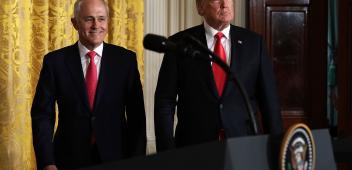How the Asian financial crisis exposed neoliberalism's limits
Originally published in the Nikkei Asian Review.

July marks the 20th anniversary of the float of the Thai baht, the opening signal of the Asian financial crisis. None who watched the crisis unfold realized at the time that it marked the end of the "Asian miracle" for the countries involved.
By the time global financial officials met in Tokyo in mid-August of that year to cobble together enough funds to supplement the International Monetary Fund's package for Thailand, we understood that this was the end of an era. The contagion had spread to Indonesia, and concerns about South Korea were growing.
Considering the disastrous outcome, it is surprising that there were not more fundamental post-crisis reforms. Just as puzzling is that when advanced European and U.S. economies experienced their own dramatic financial crisis in 2007, their response was totally different from that in 1997.
Why was there so little change to the economic structures that had proved so vulnerable in 1997? If so little was learned from the 1997 experience, why was the response to the financial crisis of 2007 so different?
By the end of 1997, many of us came to the view that the IMF was mishandling the crisis, especially in Indonesia. Its responses were exacerbating domestic errors. The available assistance package was too small; fiscal policy was tightened unnecessarily; monetary policy made an inevitably futile attempt to stabilize the newly floating exchange rate with interest rates that were cripplingly high for borrowers; banks were closed without putting in place depositor insurance to prevent runs on other banks; conditionality was aimed at unachievable structural reform.
Afterward, the IMF strenuously defended itself against all these charges. But there remains a firm resolve among the policymakers in the crisis countries never to seek IMF assistance again.
If, as the IMF asserted, its policies were not a big part of the problem, then who or what was to blame for the debacle?
With the blame focused squarely on domestic weaknesses, the crisis countries began their recoveries with policies not very different from the ones they had in place at the start.
Indonesia, for example, continued its customarily conservative budget policies; capital flows remained unconstrained; no trade restrictions were introduced to influence the current account; and the deepening of the financial sector through new institutions and instruments continued.
Policy changes were at the margins, and hardly noticeable. The managed exchange rate was given more room to respond to market forces. There was considerable intervention to stabilize the exchange rate and very substantial increases in foreign exchange reserves to support the intervention. The banking sector was trimmed, and efforts were made toward more effective prudential supervision. More importantly, macroeconomic policies became more conservative, with a willingness to trade growth for reduced vulnerability.
In short, the most egregious errors that were made during the 1997 Asian crisis were internalized, but were not relevant in post-crisis circumstances. Central bankers and policymakers agreed fiscal tightening had been a mistake, monetary policy had been grossly mishandled, and banks should never again be closed without protecting depositors. The lessons of these past mistakes were learned, but were not relevant to the post-crisis era.
What is perhaps more remarkable is that the structural and institutional factors that had created the vulnerabilities in 1997 were left largely unaddressed.
First, there had been a huge increase in global capital mobility since 1990. This changed during the first half of the 1990s, there were massive surges of capital to the fast-growing economies of Asia. Thailand received inflows equal to 14% of gross domestic product in 1996. The predictable results were appreciated currencies, surges in current accounts, and asset price bubbles as domestic borrowers tapped into cheap foreign-currency loans.
Second, these external exposures were superimposed on domestic financial sectors that were intrinsically fragile. Indonesia embarked on vigorous deregulation, especially after 1988. Everyone was also hoping at the time that the banks would narrowly escape problems, or at least not all collapse at once.
Third, there was the exchange rate dilemma. From the mid-1980s onward, the case for a greater flexible exchange rate of the Indonesian rupiah had been recognized. But the shallow embryonic foreign exchange market and volatile expectations meant that the exchange rate was not well-anchored. If left to market forces, it was likely to move in a violent manner, coming to rest far from a sensible equilibrium.
Given the devastating experience of the Asian crisis, why were these three vulnerabilities not addressed post-crisis?
The answer is that there were no viable alternatives. In the post-crisis period, the IMF was still advocating open capital markets. Some IMF staff still regretted the failure in September 1997 to amend the fund's articles to make an open capital market a prerequisite for membership.
Similarly, there was no easing of calls for further financial deregulation. The premise was that markets would deliver efficient price discovery, with any regulation or intervention harming this search for perfection. A floating exchange rate would maintain stable equilibrium. Prudential measures should be light-touch. Too much depositor protection would create "moral hazard" and distort risk-taking incentives.
The crisis countries had little opportunity to carve out fundamentally different policy paths. Their responses were at the margin, such as grow slower, hold large reserves, and do not let the current account blow out. But the basic pre-crisis framework remained intact.
For a decade, all was well, with little need for a rethink. There were no lessons here for advanced economies. As a result, it was a shock when the same financial sector vulnerabilities tripped them up.
The challenges in 2007 were simpler and largely confined to the financial sector. They were the same problems, but the response was radically different. Whereas the first move in Asia in 1997 had been to close failing financial institutions, in 2007 the whole gamut of the financial sector was propped up with an inventive mixture of mergers, guarantees and outright government support.
In 2007, the authorities recognized something that had been misunderstood in 1997: When a systemic crisis arrives, you have to save everyone, without considering whether they are illiquid or insolvent.
Without the trauma of significant reversals in capital flows or dramatic moves in exchange rates, policymakers in advanced economies were not constrained by conflicting demands. They were free to drop interest rates into historically low territory and to apply fiscal stimuli.
The difference in responses in 1997 and 2007 was partly because the crises were each different. The shared weaknesses are that financial sectors are not self-disciplining; fickle changes in confidence can cause dramatic runs on financial institutions; borrowers and lenders make lemming-like responses to correlated mistakes and markets can fail dismally.
These lessons, however, are ephemeral unless they are incorporated into institutional frameworks. As memories fade, the vulnerabilities of financial sectors, capital flows and exchange rates are forgotten -- until the next crisis hits.



